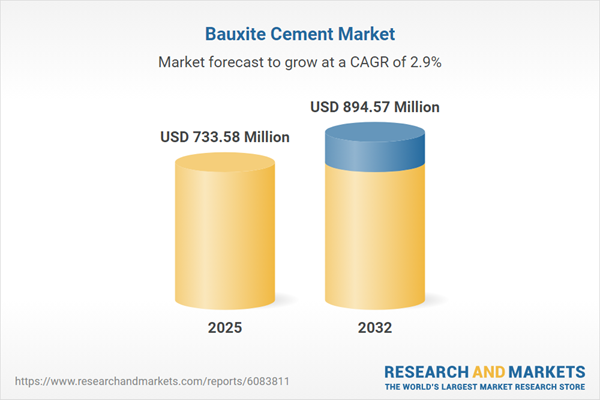Speak directly to the analyst to clarify any post sales queries you may have.
Amid rapid industrial transformation and escalating infrastructure demands, the bauxite cement market stands as a crucial enabler of high-temperature operations and sustainable construction. Senior leaders are increasingly turning to this sector for robust material solutions designed to meet evolving industry, regulatory, and operational imperatives.
Market Snapshot: Bauxite Cement Market Growth and Outlook
The Bauxite Cement Market grew from USD 712.58 million in 2024 to USD 733.58 million in 2025. It is expected to continue growing at a CAGR of 2.88%, reaching USD 894.57 million by 2032.
This trajectory reflects heightened investment in infrastructure, advanced manufacturing, and energy projects across multiple geographies. Companies navigating this landscape must adapt to changing applications, technology integration, and sustainability pressures driving both opportunity and competition.Scope & Segmentation of the Bauxite Cement Market
- Product Types: High alumina cement, medium alumina cement, ultra high alumina cement
- Applications: Monolithic refractories, gunning mass, gunning mix, plastic refractories, ramming mass, mortar, refractory castables, furnace bottom, rotary kiln, steel ladle
- End Use Industries: Construction, metallurgy, oil & gas, power generation
- Grades: Grade 1, grade 2, grade 3
- Sales Channels: Direct sales, distributor, online
- Process Technologies: Rotary kiln, sintering
- Geographical Coverage: Americas (North America, Latin America), Europe, Middle East & Africa, Asia-Pacific—with sub-regional analysis for each major economic hub
- Company Coverage: Almatis GmbH, Calucem GmbH, Kerneos S.A., Imerys S.A., RHI Magnesita N.V., Boral Limited, Holcim Ltd, China National Building Material Co., Ltd., Siam Cement Public Company Limited, Vesuvius plc
Bauxite Cement Market: Key Takeaways for Decision Makers
- Manufacturers are rapidly innovating, leveraging advancements in material science and digital process control systems to deliver grades with tailored thermal and mechanical characteristics for critical infrastructure and industrial applications.
- Cross-industry collaboration is strengthening supply chain resilience and accelerating sustainable product development, with greater attention to lifecycle impacts and carbon reduction pathways in both upstream and downstream activities.
- Regional trends shape demand: North America and South America are prioritizing domestic beneficiation and localized processing, while Asia-Pacific countries drive growth through modernization in construction, metallurgy, and power generation sectors.
- Stakeholders benefit from integrating process technology distinctions, such as rotary kiln and sintering methods, aligning efficiency strategies with application-specific usage to maximize return on investment.
- Digital transformation and real-time process analytics are enabling predictive maintenance, process precision, and faster time-to-market for innovative high-alumina solutions.
Tariff Impact: United States Policy and Global Value Chain Shifts
Recent changes in United States tariff structures have introduced complex dynamics across the bauxite cement value chain. Producers are actively diversifying sourcing strategies, seeking alternative supply corridors outside traditional regions to offset increased costs. These strategic adjustments are fostering greater market agility, driving capacity expansions, and reshaping procurement planning, especially as companies look beyond unit costs to holistic landed cost assessments when selecting suppliers and managing risk.
Methodology & Data Sources
This report draws on balanced primary and secondary research, including in-depth interviews with manufacturers, fabricators, and suppliers, as well as plant visits and reviews of technical standards and regulatory documents. Data triangulation, expert panel validation, and rigorous quality checks ensure high integrity and actionable insights.
Why This Report Matters to Industry Leaders
- Equips leadership teams with actionable intelligence on emerging technologies, sustainable production, and regional competitive shifts to guide strategy.
- Supports informed procurement and operational planning by clarifying critical segmentation, process routes, and partnership opportunities across global and local markets.
Conclusion
The bauxite cement market is evolving rapidly, driven by the confluence of technology, policy change, and shifting market dynamics. Decision-makers equipped with targeted market intelligence are well-positioned to capture growth, enhance supply chain resilience, and meet advancing industry standards.
Table of Contents
3. Executive Summary
4. Market Overview
7. Cumulative Impact of Artificial Intelligence 2025
Companies Mentioned
The companies profiled in this Bauxite Cement market report include:- Almatis GmbH
- Calucem GmbH
- Kerneos S.A.
- Imerys S.A.
- RHI Magnesita N.V.
- Boral Limited
- Holcim Ltd
- China National Building Material Co., Ltd.
- Siam Cement Public Company Limited
- Vesuvius plc
Table Information
| Report Attribute | Details |
|---|---|
| No. of Pages | 192 |
| Published | November 2025 |
| Forecast Period | 2025 - 2032 |
| Estimated Market Value ( USD | $ 733.58 Million |
| Forecasted Market Value ( USD | $ 894.57 Million |
| Compound Annual Growth Rate | 2.8% |
| Regions Covered | Global |
| No. of Companies Mentioned | 11 |









